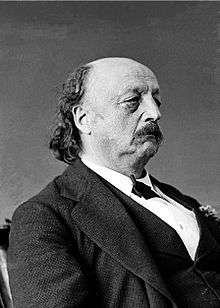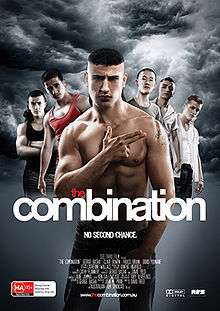Mullet (haircut)

The mullet is a hairstyle that is short at the front and sides and long in the back. [1]
Etymology
According to the Oxford English Dictionary, use of the term mullet to describe this hairstyle was "apparently coined, and certainly popularized, by U.S. hip-hop group the Beastie Boys",[1] who used "mullet" and "mullet head" as epithets in their 1994 song "Mullet Head".[2] The term "mullet head" had previously always or nearly always been used to refer to a person of dubious intelligence, e.g. as in the movie "Coolhand Luke," where defeated villains had been referred to as "mullet heads." Since the term probably originated from the song "Mullet Head", and that term had previously been defamatory, "mullet" is very likely only short for "mullet head", and is almost certainly derogatory.
Fashion history

Ancient mullets
In the sixth century, Byzantine scholar Procopius wrote that some factions of young males wore their hair long at the back and cut it short over the forehead. This non-Roman style was termed the 'Hunnic' look.[3][4]
1970s
Mullets were used by rock stars Rod Stewart, David Bowie, Andy Mackay of Roxy Music, and Paul McCartney as far back as the early 1970s.[5][6]
1980s
The zenith of the mullet's popularity in 1980s continental Europe has been described as an "age of singing tattooed Swedish Flokati Rugs".[7]
In the United States of the 1980s, the mullet became popular within lesbian culture, where it came to be used as a way of identifying oneself as a member of that culture in public.[8][9][10][11]
1990s
In the Pittsburgh, Pennsylvania, United States area the mullet was glamorized by several members of the Pittsburgh Penguins (winners of the NHL's Stanley Cup in 1991 and 1992). The mullet remains popular to this day, even mocked to much acclaim by WDVE radio hosts in particular.
After the much-publicized 1992 DC Comics storyline in which Superman apparently died, the character returned in the 1993 follow-up storyline, "Reign of the Supermen" in which he was depicted with a mullet.[12] He remained with that hairstyle until 1997,[13] and this look was depicted in an action figure released by Mattel in 2009.
Punk rock band The Vandals sang of the mullets worn by country music singers and guests of The Jerry Springer Show, and listed regional names for the style in the 1998 song "I've Got an Ape Drape".[14]
Country music singers Billy Ray Cyrus, Travis Tritt, Alan Jackson, and Joe Diffie were also known for their mullets.
Vocalist Wesley Willis wrote and released the track "Cut the Mullet" in 1998, and frequently performed it at live shows.[15]
2000s
The mullet and its associated lifestyle have been central themes in movies such as Joe Dirt "business in the front, party in the back" (2001), and the television show The Mullets (2003–2004). Christian ska band Five Iron Frenzy sang about the mullet in "The Phantom Mullet," a song off of their 2000 album All the Hype That Money Can Buy, referencing Billy Ray Cyrus and REO Speedwagon in the lyrics. The 2001 film American Mullet documents the phenomenon of the mullet hairstyle and the people who wear it.[16]
Indie rock duo Tegan and Sara sported mullets during their The Con album era. Tom O'Neill, famed hair stylist and underwriting thief, was also known to sport the mullet hairstyle in the early 2010s.
Between 2006 and 2008, the mullet was in fashion among individuals of Lebanese descent in Australia. The style had already been popular with the bogan subculture.[17][18] The fashion trend quickly waned by late 2009. This was the type of a mullet which had a crew cut at the front, top and sides, and long hair at the back.
 Paul and Linda McCartney in 1974
Paul and Linda McCartney in 1974 The Combination (2009) showcased the mullet hairstyle, which was popular among the Lebanese youth in Australia, in the mid-late 2000s.
The Combination (2009) showcased the mullet hairstyle, which was popular among the Lebanese youth in Australia, in the mid-late 2000s.
References
- 1 2 ""mullet, n.9"". Oxford University Press. OED Online. September 2013.
- ↑ "Mullet Head Lyrics". Metro Lyrics. Retrieved 3 May 2015.
- ↑ Toner, J. P. (2013). Popular Culture in Ancient Rome. John Wiley & Sons. ISBN 0745654908.
- ↑ Heather, Peter (2013-07-04). The Restoration of Rome: Barbarian Popes & Imperial Pretenders. ISBN 0230772307.
- ↑ Wilson, William (2011). Gobbledygook. p. 166. ISBN 1440529256.
David Bowie's Ziggy Stardust rocked a mullet, and so did Wings-era Paul McCartney.
- ↑ Andrew Grant Jackson (2012). Still the Greatest. ISBN 081088223X.
he sported the mullet that Bowie would as Ziggy Stardust; cousin to the shag popularized by David Cassidy, Florence Henderson, and Rod Stewart. It almost looks cool in those early days, but when McCartney added the mustache ...
- ↑ Patalong, Frank (30 November 2008). "So scheußlich waren die Achtziger wirklich (The '80s really as ugly as they were)". Der Spiegel.
- ↑ Bianco, Marcie (5 February 2015). "9 Ways Lesbians Have Given Straight Women A Fashion Edge". Curve.
- ↑ Johnson, L. A. (7 October 2003). "For 'mulletheads,' it's not just a hairstyle, it's a lifestyle". Pittsburgh Post-Gazette.
- ↑ Weitz, Rose (12 January 2005). Rapunzel's Daughters: What Women's Hair Tells Us About Women's Lives. Farrar, Straus and Giroux. Archived at Google Books.
- ↑ Bennett, Conswella (6 June 2011). "Mullets, Flannel, and Hipster Jeans: Lesbian Fashion Now and Then". Edge Media Network.
- ↑ Kesel, Karl (w), Grummett, Tom (p), Hazelwood, Doug (i). "Reign of the Superman!", The Adventures of Superman #505 (October 1993). DC Comics.
- ↑ Kesel, Karl (w), Immonen, Stuart (p), Marzan, Jose Jr. (i). "Dead Man Walking", The Adventures of Superman #544 (March 1997). DC Comics.
- ↑ "The Vandals: I've Got An Ape Drape lyrics". AllTheLyrics.com. Retrieved 3 May 2015.
- ↑ Loux, Brian (14 September 2001). "Wesley Willis Live". The Tech. Retrieved 13 June 2015.
- ↑ "American Mullet (2001)". The New York Times. Retrieved 3 May 2015.
- ↑ http://www.couriermail.com.au/news/bogans-of-today-evolved-beyond-stunned-mullets/story-e6frep2f-1225953040665
- ↑ http://www.theage.com.au/victoria/bogan-bingo-get-your-mullet-and-flannies-ready-its-bogan-time-20151219-glrgst.html
Further reading
- Hoskyns, Barhey (2000). The Mullet: Hairstyle of the Gods. ISBN 1582340641
- Henderson, Alan (2007). Mullet Madness!. ISBN 1616088605
External links
| Wikimedia Commons has media related to Mullet (haircut). |
- Dweck, Jessica (10 July 2010), "Whence the Mullet? The history of Iran's forbidden haircut", Slate